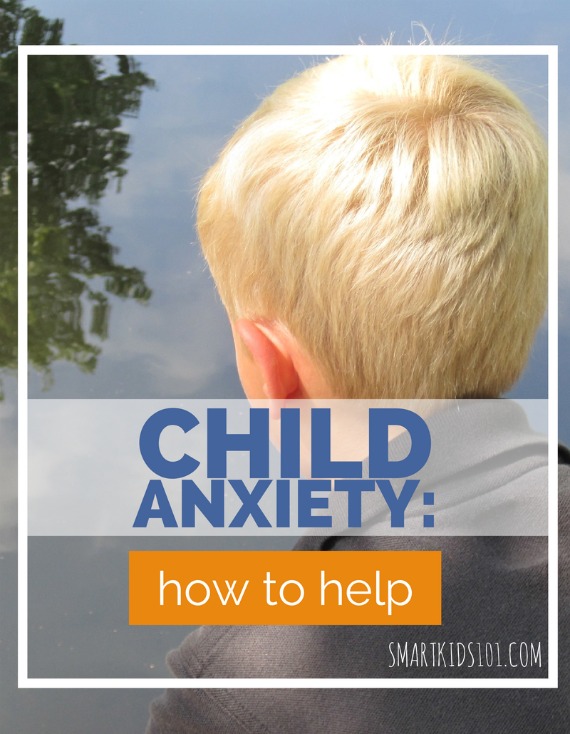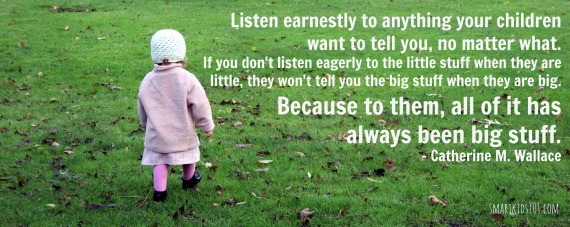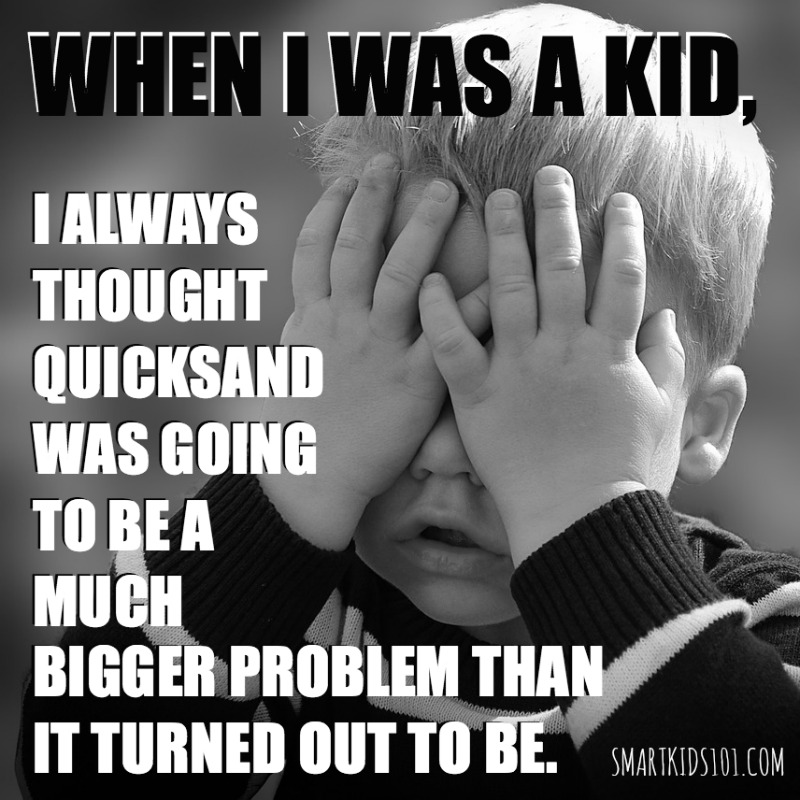Child Anxiety: What to Do and How to Help Your Child

Child anxiety is a very common occurrence. Whether it’s worrying over a thunderstorm or a trip to the doctor, anxiety is a normal part of child development. These fears help children sort out what they need to defend themselves against and what is not actually a threat.
Keys to Handle Child Anxiety
It’s hard to see your precious child going through something upsetting. And it’s also hard to keep going around and around the same problem, never seeming to solve anything. So you may wonder how to help a child with anxiety. Here are some tips to having a more calm child:
1. Words Matter
Want to really know how to help a child with anxiety? Help your child work through their problems. Saying, “Oh, that won’t happen” or “Stop worrying about it” isn’t entirely true — and kids know that. In life, bad things do happen. Try saying, “I love you and we’ll work through whatever frightens you.”
Our kids hear about unsettling things everyday — kidnappings, abuse, death, divorce, not making the team, a bad report card. All these can seem frightening to children, and they look to the adults in their lives for assurance, coping strategies, and protection.
So talk with your child. What are his concerns, fears, and worries?
2. Make a Plan
With the help of your child, make a list of the fears and talk through each one. Make a plan for handling them if they actually happen. Enlisting your child’s help in this step is key because it helps him learn the problem-solving techniques that he will need as he grows and works through problems on his own.
Parents are essential in helping their children understand that worrying doesn’t stop bad things from happening. By talking through it with them and making a plan, you’re actually modeling the internal thinking grownups go through when coping with a fear.
 3. Know the Difference Between Fear & Anxiety
3. Know the Difference Between Fear & Anxiety
There’s a practical benefit in knowing the difference between sensing danger and feeling afraid. Being aware of a bad situation can prompt a person to take positive action. Being afraid often immobilizes a person, which actually increases the possibility of suffering harm.
Teach your kids that if their thoughts start multiplying, they might be engaging in unnecessary worry. Often they’ll be able to work through a concern by questioning the situation. Could it really happen? Could I do anything to prevent it? Reassure them that if they cannot overcome a worry, that you’ll be happy to discuss it with them.
Current research also gives parents some helpful tips on how to help a child with anxiety. Check out what they say:
1. Watch Your Words
Does this surprise you? Probably not. While there are many things that may cause anxiety, studies suggest one factor is how parents communicate with their kids.
Specifically, studies like Hosey and Woodruff-Borden (2012) show that parents who communicate negative emotion (using words like fearful, sad, or nervous) when talking with their children may cause the child’s brain to signal danger.
(I cringe to think how many times I’ve said, “Don’t do that, honey. That makes Mommy nervous.” Oops.)
This bias may then become associated mentally with other similar situations, even when little to no danger is actually present.
2. Land the Helicopter
Related to the previous idea, the same study by Hosey and Woodruff-Borden (2012) suggests that so-called “Helicopter Parenting” (you know — hovering over your child’s every move) can contribute to child anxiety as well.
I’m guilty of this so often — I see potential problems or mistakes before my kids do, and I warn them. I don’t want him to skin his knee! I don’t want her to have a tummy ache! These are all good motives, but part of childhood is also learning the consequences of your own choices.
So don’t be afraid to let them make mistakes. That’s a big part of how kids learn! Hosey and Woodruff-Borden also suggest that being less controlling and more accepting of your children and their choices can help them overcome child anxiety.
(I should probably note, this is within reason. Please use your best judgment when parenting your kids!)
 3. Know the Child Anxiety Signs
3. Know the Child Anxiety Signs
Most kids eventually grow out of child anxiety. If your child seems to be showing anxiety beyond his or her maturity level, or if your child shows what’s called “excessive anxiety” (when the fear is disproportionately large compared to the threat), please speak to a professional to assess whether there are another techniques that can be used to further assist your child.
Have you ever dealt with child anxiety? Do you have some tips to add for how to help a child with anxiety? Please share them in the comments!
(Linked up to: Project Inspire{d}, Prototype Mama, SITS Girls, and Wordy Wednesday)
READ NEXT: Top 5 Steps to Help Your Child Have a Better School Year – Instantly!
21 thoughts on “Child Anxiety: What to Do and How to Help Your Child”
Comments are closed.
Modeling is so key, isn’t it?
They’re always watching us, and constantly learning, and sometimes what they’re picking up from us is the very thing we wish they wouldn’t!
Amen! It shocked me when my daughter’s friend picked a fight with me! And I do mean “picked”, as in, opened my wound right up! Mothering also prompted me to deal with some of the junk I thought I’d left in the school yard. House cleaning is always so much fun!
What great tips! I especially agree with the part about parents communicating negative or fearful words. I’m a preschool teacher of 2 year olds and the parent reactions when dropping them off the first week play a HUGE part in how the child will handle the situation. A parent who is crying or has a distressed or fearful look on their face is communicating to the child that there is reason for them to be upset!
Good point… that makes total sense. Thanks for sharing an example from your expertise!
Anxiety is something that we all deal with and I appreciate you bringing childhood anxiety to a discussion. My son had childhood anxiety and still deals with it today. It can be a life long struggle, and as a mom, how you handle it when they are young, can make a difference later in life.
Exactly! Thanks for stopping by and commenting!
This is an amazing article! My daughter is on the autism spectrum and deals with anxiety on a regular basis. I was actually interested in using this as a guest post next week! I will email you details:) *Visiting from Type A Parent Link up!
Thank you so much for your kind words! I am glad you found it helpful. I’ll be contacting you shortly about guest posting. Thanks for asking!
Great tips Aubrey!
Thanks so much for linking up this important post with us at Project Inspire{d}!
You’re welcome, Diane! Thanks, as always, for hosting and stopping by to comment. Have a great weekend!
These are really helpful tips. 🙂 I’ve been “arming” myself with all these great tips on how to best raise a child from mommy bloggers like me. I just want to be prepared when our daughter comes. 🙂 I definitely witnessed (from my friend and her daughter) how not doing the helicopter parenting works. Her daughter is turning 2 and as soon as she can walk, they just let her be, even when she falls down (of course mildly), they don’t immediately rush to her to soothe her. They let her get back up on her own. Instead of their daughter crying her heart out from a fall that isn’t really that bad, she just picks herself up like nothing happened. It’s really amazing! 🙂
We did a similar thing with our kids — not making a big deal when they would stumble (unless of course they were really hurt), and it was amazing for their confidence. It was hard sometimes, because my natural response was to gasp when my child fell, but when I got over that, it was amazing how my son (and now my daughter, too) wouldn’t even cry or be scared. It made me realize that many times their response was to my over-reacting. What a revelation! Thanks for reminding me of that great tip — it’s SO relevant to what I was trying to convey above! So glad this post was helpful, and best wishes when your daughter arrives! That’s exciting!
These are great tips.
When I talk to children about anxiety I always use the seed analogy. If you give a seed water, food and attention it grows, if you leave it in a room and do nothing, nothing happens. Whilst it’s important to recognise and work through anxiety, it’s always important that we don’t give it too much attention.
Thanks for your input, Dr. Kellie! I LOVE that analogy. I know that principle is true in my life — the more I fret, the bigger a “problem” can become, but if I ignore it and it’s truly not a problem, it takes care of itself. Also teaching kids that principle can be SO valuable. You have an awesome blog yourself with lots of resources. I want to drop this link of yours in, just in case someone reading the comments here wants more ideas for helping with Child Anxiety: http://drkelliejones.com/2014/10/05/helping-children-worries-magic-potion/ Thanks again for stopping by! 🙂